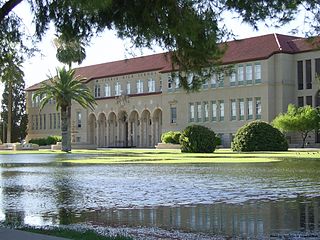
Peoria is a city in Maricopa and Yavapai counties in the U.S. state of Arizona. Most of the city is located in Maricopa County, while a portion of it in the north is in Yavapai County. It is a major suburb of Phoenix. As of the 2020 census, the population of Peoria was 190,985, up from 154,065 in 2010. It is the sixth-largest city in Arizona in land area and the ninth-largest in population. It was named after Peoria, Illinois. The word peoria is a corruption of the Miami-Illinois word for "prairie fire". It is the spring training home of the San Diego Padres and Seattle Mariners, who share the Peoria Sports Complex.
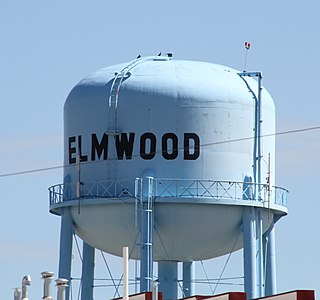
Elmwood is a city in Peoria County, Illinois, United States. The population was 2,097 at the 2010 census. Elmwood is part of the Peoria, Illinois Metropolitan Statistical Area.

Urban renewal is a program of land redevelopment often used to address urban decay in cities. Urban renewal involves the clearing out of blighted areas in inner cities to clear out slums and create opportunities for higher class housing, businesses, and other developments. In the United States the term technically refers only to a federal program in the middle-to-late 20th Century, but colloquially is sometimes used to refer to any large-scale change in urban development.
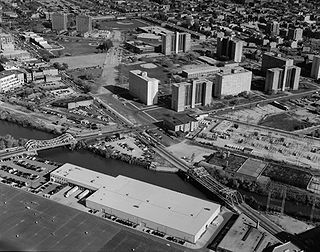
Cabrini–Green Homes was a Chicago Housing Authority (CHA) public housing project on the Near North Side of Chicago, Illinois. The Frances Cabrini Rowhouses and Extensions were south of Division Street, bordered by Larrabee Street to the west, Orleans Street to the east and Chicago Avenue to the south, with the William Green Homes to the northwest.
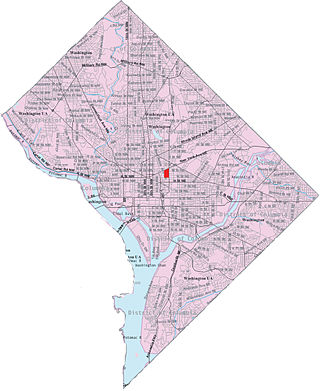
Sursum Corda is a small neighborhood located in Washington, D.C., bounded by North Capitol Street on the east, K Street NW to the south, New Jersey Avenue NW to the west, and New York Avenue NW to the north.
The Jeffries Homes, also called the Jeffries Housing Projects, was a public housing project located in Detroit, Michigan, near the Lodge Freeway. It included 13 high-rises and hundreds of row house units, and was named for Detroit Recorder's Court Judge Edward J. Jeffries, Sr., who was also father of Detroit Mayor Edward J. Jeffries, Jr.

Yesler Terrace is a 22-acre (8.9 ha) public housing development in Seattle, Washington, United States. It was completed in 1941 as the state's first public housing development and the first racially integrated public housing development in the United States. It occupies much of the area formerly known as Yesler Hill, Yesler's Hill, or Profanity Hill. The development is administered by the Seattle Housing Authority, who have been redeveloping the neighborhood into a mixed-income area with multi-story buildings and community amenities since 2013.

East Liberty is a neighborhood in Pittsburgh, Pennsylvania's East End. It is bordered by Highland Park, Morningside, Stanton Heights, Garfield, Friendship, Shadyside and Larimer, and is represented on Pittsburgh City Council by Councilwoman Deborah Gross and Rev. Ricky Burgess. One of the most notable features in the East Liberty skyline is the East Liberty Presbyterian Church, which is an area landmark.
HOPE VI is a program of the United States Department of Housing and Urban Development. It is intended to revitalize the worst public housing projects in the United States into mixed-income developments. Its philosophy is largely based on New Urbanism and the concept of defensible space.
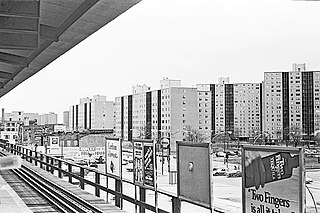
Stateway Gardens was a Chicago Housing Authority (CHA) public housing project located in the Bronzeville neighborhood on the South Side of Chicago, Illinois.

The Lafitte Projects were one of the Housing Projects of New Orleans and were located in the 6th Ward of New Orleans Treme neighborhood. It was one of Downtown New Orleans' oldest housing developments and had many associated problems before being severely flooded and damaged during Hurricane Katrina in 2005. The project made national headlines after the gruesome murder of Thomas May who burned to death in the project in 1994. By a Department of Housing and Urban Development (HUD) decree, the projects were demolished and redeveloped as affordable, mixed-income housing. The redevelopment effort was charged with replacing every demolished unit. The large housing project was left mostly vacant following evacuations after the extensive flooding from Hurricane Katrina. Heated arguments have surrounded the demolition of the project, as some longtime residents wanted them renovated.
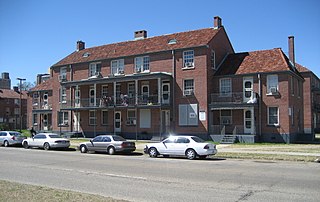
Iberville Projects was a neighborhood in the city of New Orleans and one of the low-income Housing Projects of New Orleans. The Iberville was the last of the New Deal-era public housing remaining in the city. Its boundaries were St. Louis Street, Basin Street, Iberville Street, and North Claiborne Avenue. It is located in the 6th ward of downtown New Orleans, on the former site of the Storyville district. The area has recently been redeveloped into a modernized apartment complex called the Bienville Basin Apartments.

The William J. Fischer Housing Development, better known as the Fischer Projects, was a housing project in Algiers, New Orleans, Louisiana, United States. It was known notoriously for a series of high-profile murders in the 1970s and 1980s. It was also the last conventional public housing development constructed in New Orleans and originally consisted of a 13-floor high-rise and fourteen 3-floor units. The area has been undergoing redevelopment since about 2004 and currently none of the original low-rise buildings remain. The development is located along Whitney Avenue in the Algiers area of the city's west bank, which is part of the 15th Ward and is named for William J. Fischer who served as chairman of HANO in the 1950s. The property is now converted to a small low-income housing development.

Barclay is a neighborhood in the center of Baltimore City. Its boundaries, as defined by the City Planning Office, are marked by North Avenue, Greenmount Avenue, Saint Paul and 25th Streets. The neighborhood lies north of Greenmount West, south of Charles Village, west of East Baltimore Midway, and east of Charles North and Old Goucher. The boundary between the Northern and Eastern police districts runs through the community, cutting it roughly in half.

Henry Horner Homes was a Chicago Housing Authority (CHA) public housing project located in the Near West Side community area on the West Side of Chicago, Illinois, United States. The original section of Henry Horner Homes was bordered by Oakley Boulevard to the west, Washington Boulevard to the south, Hermitage Avenue to the east, and Lake Street to the north near the United Center. A discontiguous section named Horner Annex was bordered by Honore Street to the west, Adams Street to the south, Wood Street to the east, and Monroe Street to the north. Constructed between 1957 and 1963, The housing project was named in honor of former Illinois governor Henry Horner.

In the United States, subsidized housing is administered by federal, state and local agencies to provide subsidized rental assistance for low-income households. Public housing is priced much below the market rate, allowing people to live in more convenient locations rather than move away from the city in search of lower rents. In most federally-funded rental assistance programs, the tenants' monthly rent is set at 30% of their household income. Now increasingly provided in a variety of settings and formats, originally public housing in the U.S. consisted primarily of one or more concentrated blocks of low-rise and/or high-rise apartment buildings. These complexes are operated by state and local housing authorities which are authorized and funded by the United States Department of Housing and Urban Development (HUD). In 2020, there were 1 million public housing units.
In 1994 the Atlanta Housing Authority, encouraged by the federal HOPE VI program, embarked on a policy created for the purpose of comprehensive revitalization of severely distressed public housing developments. These distressed public housing properties were replaced by mixed-income communities.

Julia C. Lathrop Homes is a Chicago Housing Authority (CHA) public housing project located along the line between the Lincoln Park and North Center neighborhoods on the north side of Chicago, Illinois, United States. It is bordered by the neighborhoods of Bucktown and Roscoe Village. Completed in 1938 by the Public Works Administration, Lathrop Homes was one of the first Chicago public housing projects. Lathrop Homes was placed on the National Register of Historic Places in 2012 and is currently undergoing restoration. Lathrop Homes consists of two-story brick row houses and three- and four-story apartment buildings separated by landscaped courtyards and linked by small archways in a campus-like arrangement. There are a total of 925 units on 35.5 acres of land.

Howard County Housing is the umbrella organization for the Howard County Department of Housing and Community Development and the Howard County Housing Commission. The Department is Howard County Government’s housing agency, and the Commission is a public housing authority and non-profit. Both have boards that meet monthly.
Valleyview Homes, now Tremont Pointe, was originally built in 1939 in the Tremont neighborhood, overlooking Cleveland's industrial valley. As one of the country's oldest public housing estates, the original design was a World War II barrack style layout with small units lacking contemporary amenities and was separated by 72 vertical steps. In addition, the site was adorned with a large number of Works Progress Administration (WPA) artwork. By 2004, Valleyview Homes had become one of CMHA's most distressed public housing estates, and some of the art was badly damaged.

















